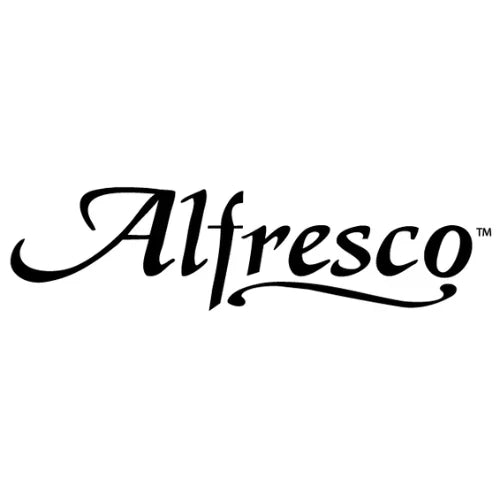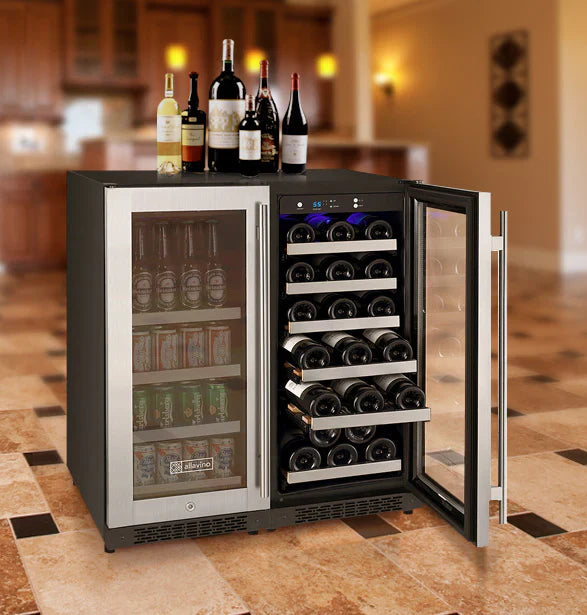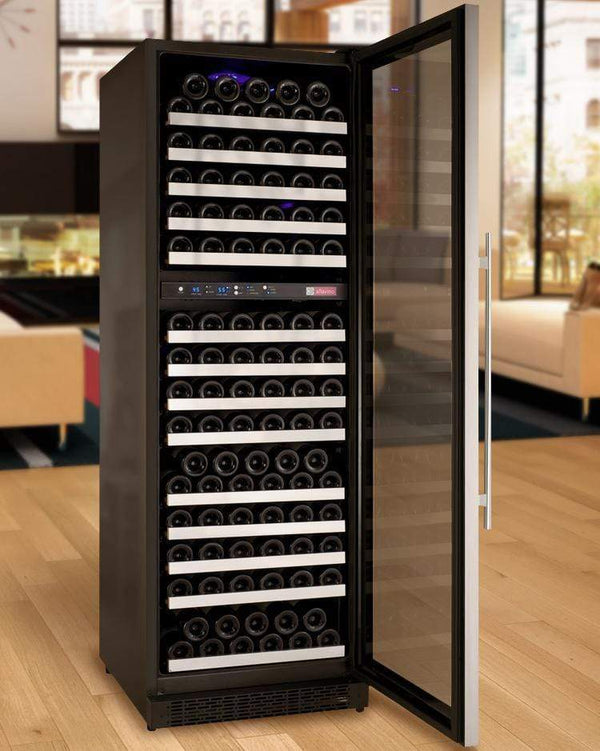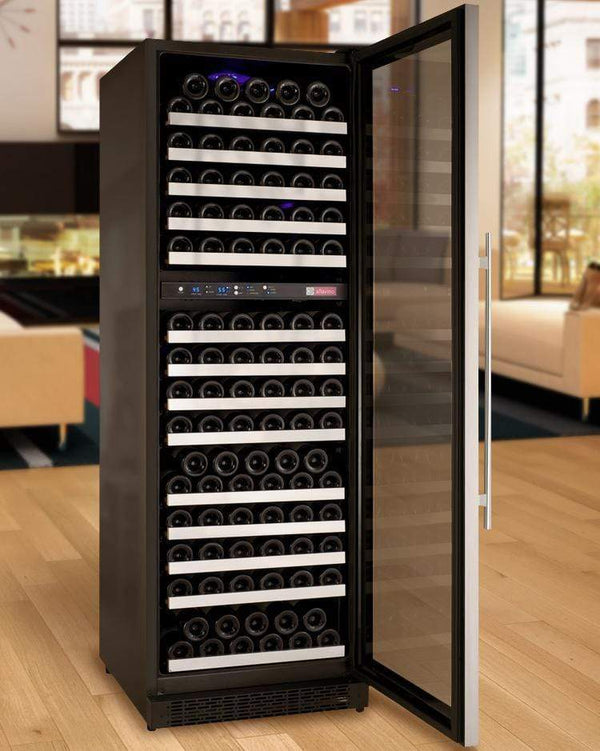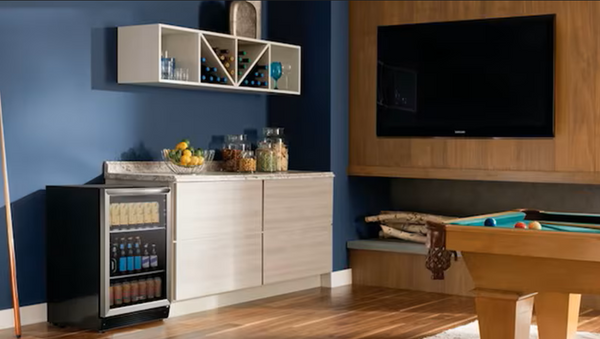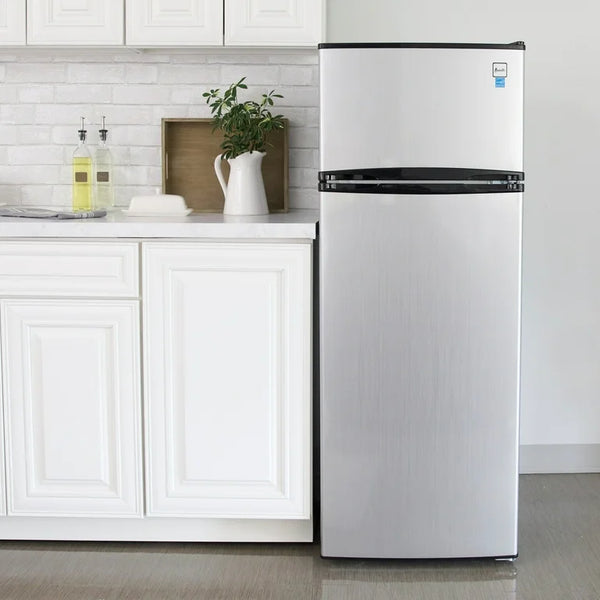How to Choose Wine Rack Bottle Capacity for Your Home
🤔 Not Sure What Size Wine Rack You Need? Let’s Figure It Out.
By Jim Hopper, Wine Cooling Expert
From casual sipping to serious collecting, your wine lifestyle and space dictate the perfect rack size. In this guide, we’ll help you calculate how many bottles you should plan for — and how to choose a storage solution that fits both your needs and your home.
For a complete overview of styles, materials, and sizing tips, check out our ultimate wine rack buying guide.

📐 Step 1 – Know Your Wine Habits
Start by looking at your real-life wine usage. Here’s a quick formula:
(Bottles consumed per week) × (Weeks you store between purchases) = Minimum bottle capacity
Examples:
- 2 bottles/week × 4 weeks = 8 bottles → round up to 12
- 3 bottles/week × 6 weeks = 18 bottles → plan for 24
🍷 Wine Lifestyle Matrix
| Wine Lifestyle | Weekly Use | Buying Style | Suggested Bottle Capacity |
|---|---|---|---|
| Casual Sipper | 1–2 bottles | Buy as needed | 6–12 bottles |
| Entertainer | 3–6 bottles | Bulk/case orders | 24–36 bottles |
| Collector | 1–4 bottles | Long-term aging | 48–100+ bottles |
💡 Planning Tip: Add 20–30% extra room for growth.
If you're unsure how much space each style requires, our how to measure for a wine rack explains everything from bottle width to layout impact.

🏡 Step 2 – Match to Your Living Space
Your home layout affects how much wine you can realistically store:
🏙️ Apartments or Small Homes
- Ideal: 6–24 bottles
- Best: Wall-mounted, under-counter, slim freestanding
- See our best wine racks for small spaces
🏠 Suburban Homes or Bar Areas
- Ideal: 24–72 bottles
- Best: Modular cubes, console racks, bar carts
If you’re planning a dedicated wine room or cellar, our Wine Cellar Design support service can help you create a storage solution that perfectly fits your space and collection goals.
🍾 Wine Rooms or Cellars
- Ideal: 100–1,500 bottles
- Best: Custom racks, cooling-ready systems
💡 Design Note: Avoid sunlight and appliances that generate heat.
If you’re outfitting a dedicated cellar, don’t miss our roundup of the best wine racks for wine cellars.

🍷 Step 3 – What Type of Drinker Are You?
Your wine habits define your rack size:
🧑🍳 Casual Sipper
- 6–12 bottles
- Countertop or wall-mounted racks
🥂 Social Host
- 24–36 bottles
- Freestanding racks or bar carts
🪵 Collector
- 48–100+ bottles
- Modular systems or cellar units
💡 Upgrade Tip: Many people grow into the next tier — plan your storage like your collection will expand.
You can also check out our wine rack buying guide for material tips and long-term planning.

🧱 Step 4 – Choose by Rack Style
📦 6–12 Bottles
Under-cabinet, countertop, or decorative small racks
🪑 12–36 Bottles
Slim towers, stackables, bar carts with storage
🧊 36–100 Bottles
Modular cubes, wall grid systems
🏰 100+ Bottles
Cellar-grade racks with climate control support
If you’re comparing finishes and materials, check out our wood vs metal wine racks guide to decide what works best in your space.
💡 Pro Tip: Some wine racks are designed to be expandable or include accessories like glass holders and tabletop surfaces. If you plan to grow your collection or want a rack that doubles as a serving station, look for these added features.
Curious about more options? Explore our overview of the different types of wine racks.

🪵 Wine Rack Materials and Construction: What to Know
When choosing a wine rack, the material plays a big role in both its look and longevity. Here’s what to consider:
Common Wine Rack Materials
-
Wood:
Popular woods include oak, walnut, mahogany, pine, and maple. Hardwoods like oak and walnut are known for their strength, unique grain patterns, and durability—making them ideal for long-term storage and wine cellars. Softer woods like pine offer a lighter look and are often more budget-friendly. -
Metal:
Metal racks are typically made from steel or iron and are valued for their strength, modern style, and slim profiles. Many come in finishes like matte black, brushed nickel, or chrome and are coated for protection against moisture.
Durability and Suitability
-
Wood Racks:
Hardwoods resist warping and moisture, making them a top choice for cellars or humid environments. Protective finishes or sealants (like water-based clear coats) can add extra defense and preserve color. -
Metal Racks:
Metal is highly durable and often requires less maintenance. Coated finishes help prevent rust and make these racks suitable for kitchens, bars, or commercial spaces.
Aesthetic Considerations
- Wood racks offer a classic, warm appearance with visible grain and color variations. They can complement traditional décor or add a natural touch to modern spaces.
- Metal racks have a sleek, contemporary look and can turn your wine collection into a visual centerpiece.
Maintenance
- Wood racks may need periodic dusting and, if unfinished, occasional refinishing.
- Metal racks usually just need a wipe-down to keep their finish looking sharp.
Tip:
When selecting a wine rack, consider the environment (humidity, temperature), your décor, and how much maintenance you’re comfortable with. Both wood and metal can be excellent choices if matched to your needs.
🖼️ Explore Wine Rack Design Options and Customization
Wine racks come in a wide variety of designs to fit your space, style, and storage needs. Whether you want a classic look, a modern statement, or a custom solution, there’s a wine rack design for you.
Standard Wine Racks
These racks offer traditional, straightforward bottle storage and are ideal for countertops, cabinets, or small spaces. Standard racks come in various widths and heights to fit your available area.
Modular and Stackable Wine Racks
Modular racks are designed for flexibility. You can start with a small unit and add more as your collection grows, or stack and combine modules to fit unique layouts. This makes them perfect for expanding collections and for customizing storage under stairs, in corners, or along full walls.
Wall-Mounted Wine Racks
Wall-mounted racks save floor space and turn your bottles into a visual display. They’re available in single or multi-bottle depth, and many offer sleek, modern designs that showcase bottle labels. Some models can be joined together to create a dramatic “wine wall” effect.
Discover why wall-mounted racks are a smart choice for saving space and style in our article on the benefits of wall-mounted wine racks.
Freestanding Wine Racks
Freestanding racks are versatile and can be placed anywhere—kitchens, dining rooms, or home bars. They range from compact towers to large-capacity units and often double as decorative furniture. Some freestanding racks include tabletop surfaces or integrated display rows.
Custom and Bespoke Wine Racks
If you have a unique space or specific design vision, consider custom wine racks. Many brands and builders offer design services to create racks that fit your exact dimensions, match your décor, or maximize awkward spaces. Customization options often include:
- Choice of finish or color to complement your home
- Selection of materials and hardware styles
- Adjusted dimensions for under-stairs, alcoves, or entire cellars
- Integration of display rows or tasting tables for presentation
Design Tip:
When planning your wine rack, think about both function and style. Custom finishes, unique layouts, and tailored features can turn your storage into a true focal point.
📈 Step 5 – Plan for the Future
Wine collections grow faster than expected. Here’s how to stay ahead:
- ✅ Add 20–30% more capacity than you need today
- ✅ Choose modular racks that stack or expand
- ✅ Leave space for new finds, gifts, or wine club deliveries
💡 Example: If you store 24 bottles now, go with 30–36 or expandable racks.
Enhancing your wine storage isn’t just about capacity—thoughtful features and accessories can make your wine rack more functional and visually appealing. Here are some popular options to consider:
-
Stackable and Modular Designs:
Many racks offer stackable or modular options, allowing you to expand your storage as your collection grows. This flexibility is perfect for collectors who anticipate adding more bottles over time. -
Display Rows and Tasting Tables:
Some racks include dedicated display rows to showcase bottle labels or a built-in tasting table for pouring and serving. These features combine storage with presentation, making your collection a focal point. -
Glass Holders and Stemware Storage:
Look for racks with integrated glass holders or shelves for stemware, so everything you need for serving is in one place. -
Crown Molding, Toe Kicks, and Tabletop Surfaces:
Accessories like crown molding and toe kicks give racks a built-in, finished look, while tabletop surfaces provide space to prep or serve. -
Specialty Racks for Custom Spaces:
Modular systems and specialty racks can be configured to fit under stairs, in corners, or as part of a dedicated wine cellar—maximizing storage in unique spaces. -
Protective Finishes and Stability Add-ons:
Some racks feature protective coatings, special finishes, or added grips for stability, ensuring both your bottles and your rack stay in top condition.
These features can elevate your wine storage from simple shelving to a functional design statement that adapts to your needs.
Looking for tips on managing a growing collection? Here’s how to organize a wine cellar like a pro.
🍇 Wine Storage Best Practices: Orientation, Depth & Environment
Suggested Content:
Proper wine storage goes beyond just choosing the right rack size. To keep your collection in optimal condition, follow these best practices:
Bottle Orientation:
- Store bottles horizontally, especially those with corks. This keeps the cork moist, preventing air from entering and spoiling the wine.
Rack Depth:
- Use racks with a minimum depth of 12.5" to 13.5" to fully support standard wine bottles. This protects bottles from accidental knocks and ensures long-term safety.
Environmental Conditions:
- Place wine racks in cool, dark areas away from direct sunlight and heat sources. - Maintain a consistent temperature, ideally between 55–65°F (13–18°C). - Aim for moderate humidity (50–70%) to protect corks from drying out. - Avoid areas with frequent vibration or strong odors, as these can affect wine aging.
Quick Reference Table:
Best Practice Recommendation Orientation Horizontal for corked bottles Rack Depth 12.5"–13.5" minimum Temperature 55–65°F (13–18°C) Humidity 50–70% Light Avoid direct sunlight Vibration Store in a stable, low-vibration spot
2. Enhance Your “Step 2 – Match to Your Living Space” Section
Addition (after “Design Note: Avoid sunlight and appliances that generate heat.”):
For long-term storage, prioritize locations with stable temperature and humidity, such as interior closets or dedicated wine cellars. If storing wine in a kitchen or living space, avoid placing racks near ovens, dishwashers, or windows to prevent heat and light exposure.
3. Add a “Why Horizontal Storage Matters” Callout in Step 4 – Choose by Rack Style
Addition (after listing rack styles):
Why Horizontal Storage Matters:
Horizontal racks keep corks moist and airtight, which is essential for preserving wine quality over time. Vertical storage can dry out corks and risk oxidation, especially for bottles you plan to age.
4. Expand on Materials and Finishes in “Wine Rack Materials and Construction: What to Know”
Addition (after “Durability and Suitability”):
Protective finishes—such as water-based clear coats—add an extra layer of defense against humidity and moisture, helping both wood and metal racks last longer and better protect your wine.
🛠️ Assembly and Installation Guidelines
Once you’ve selected the right wine rack size, proper assembly and installation ensure your bottles stay safe and your rack lasts for years. Here’s what to expect and how to get started:
Step-by-Step Assembly Basics
- Read the Instructions: Always review the manufacturer’s assembly guide before you begin. Most racks include detailed instructions, and some offer video or app-based tutorials for extra guidance.
- Prepare Your Tools: Common tools include a screwdriver, power drill, or nail gun (for wood racks). Some racks require specific hardware—check if screws, nails, or wall anchors are included or need to be purchased separately.
- Assemble Components: Follow the step-by-step instructions to connect frame pieces, secure shelves, and attach any finishing elements like crown molding or toe kicks.
Installation Tips for Stability and Safety
- Freestanding Racks: Place on a level surface. For taller racks, use included anti-tip hardware or brackets to anchor the unit to the wall and prevent tipping.
- Wall-Mounted Racks: Use the recommended wall anchors or screws for your wall type (drywall, wood, or masonry). Double-check that the rack is level before tightening all fasteners.
- Final Check: Ensure all joints and fasteners are secure. Avoid overloading the rack beyond its rated capacity, and periodically inspect for stability.
Pro Tips
- If your rack includes special grips or stability features, install them as directed for extra security.
- For custom or large installations, consider professional help to ensure a safe, lasting setup.
With the right preparation and care, assembling and installing your wine rack can be straightforward—and you’ll enjoy peace of mind knowing your collection is safely stored.
📞 Need Help Choosing the Right Wine Rack Size?
👋 Got questions? Need help choosing the right wine cooling system for your space?
Our experts at Wine Coolers Empire are here to guide you.
📞 Call us today at 1-888-407-7770 for your FREE Cooling Consultation!
📧 Or email us at support@winecoolersempire.com
🛒 Shop Wine Cooling Systems at Wine Coolers Empire
Looking to create a custom wine cellar or need expert design advice? Visit our Wine Cellar Design page for personalized support and inspiration.
📚 Frequently Asked Questions (FAQs)
How do I know how many bottles to plan for?
Is it better to go slightly bigger than I need?
Do I need a cooling unit for my wine rack?

Designing or Upgrading a Wine Cellar?
We got you! Here at Wine Coolers Empire, we will guide you in building your dream wine cellar.




